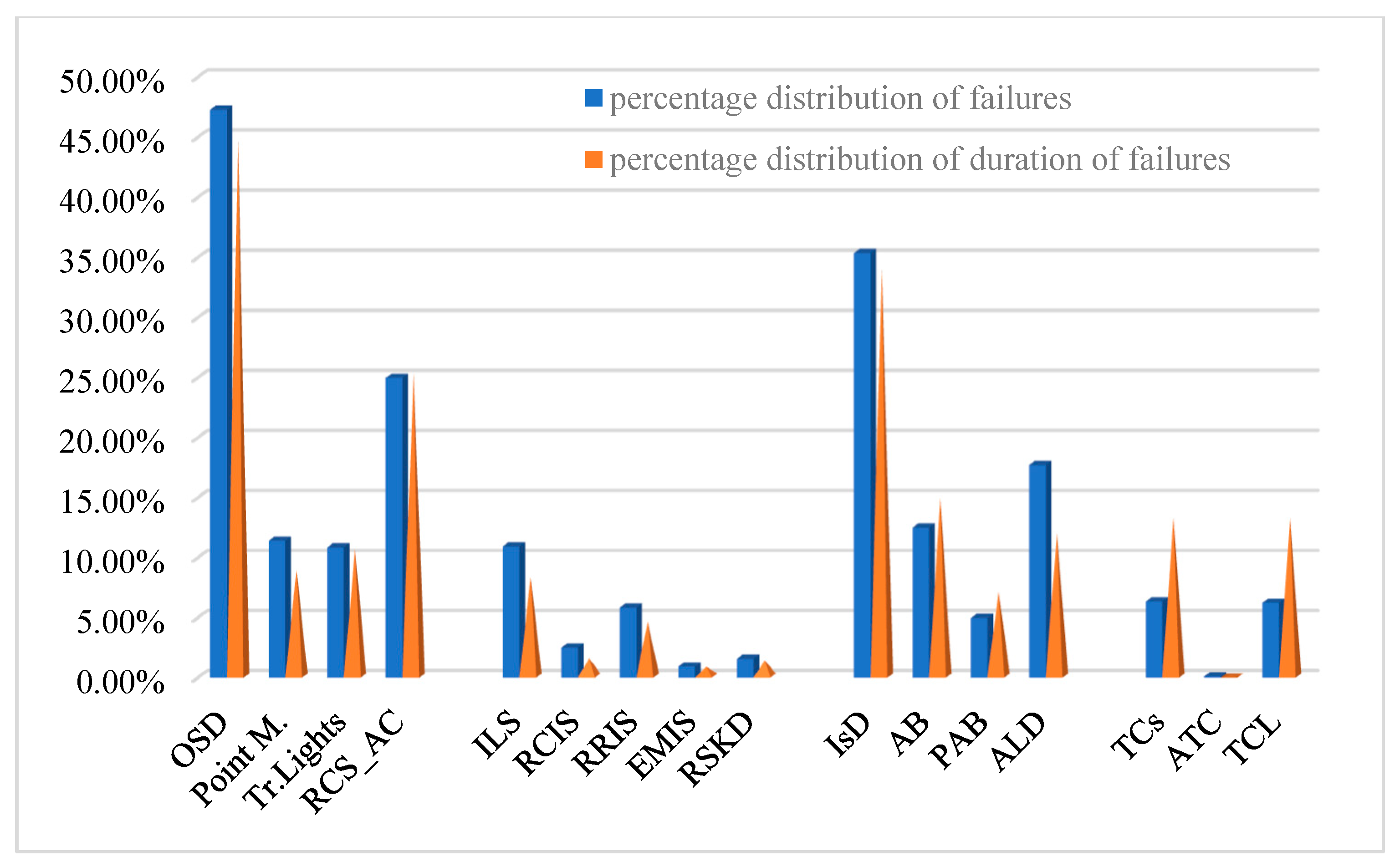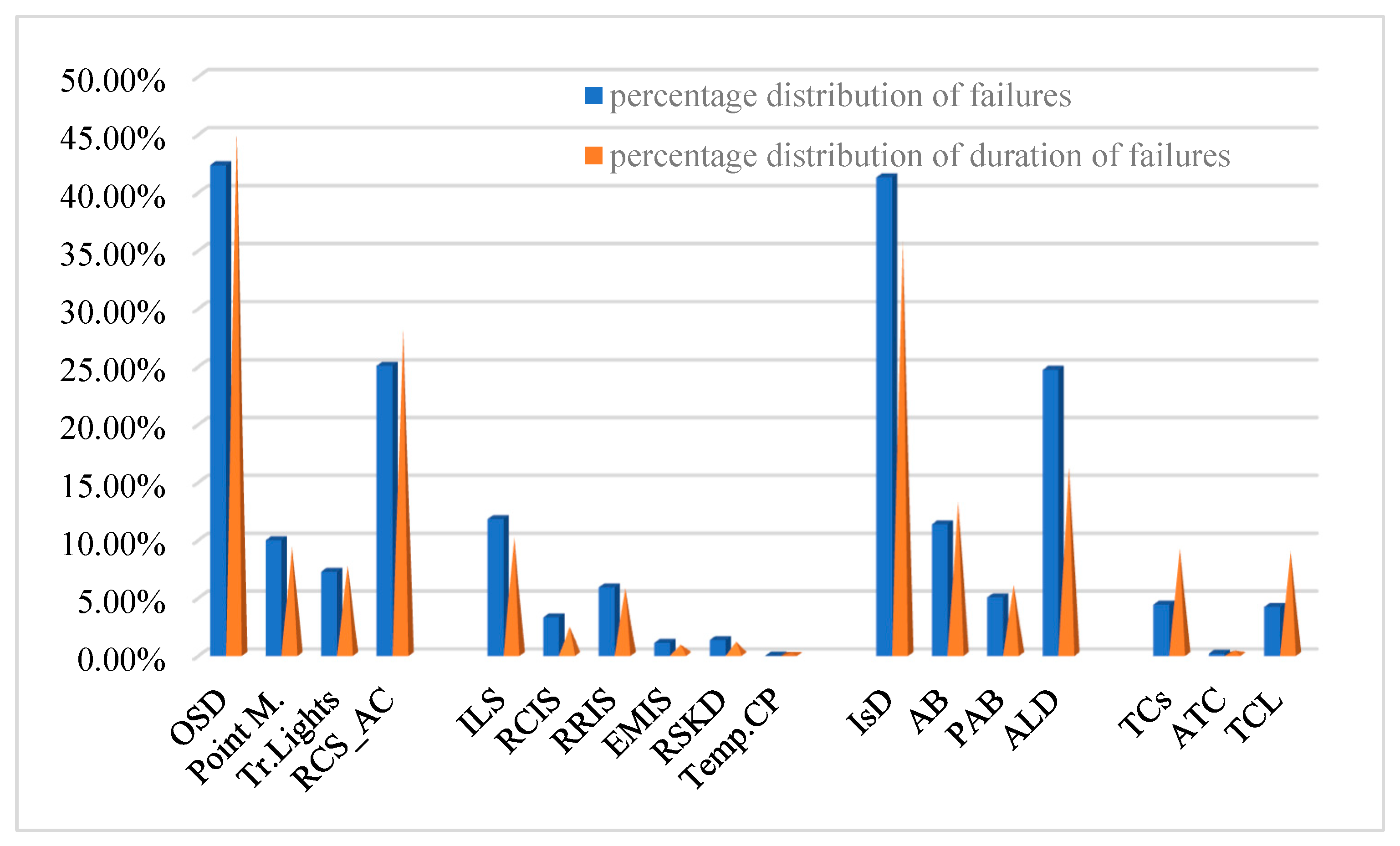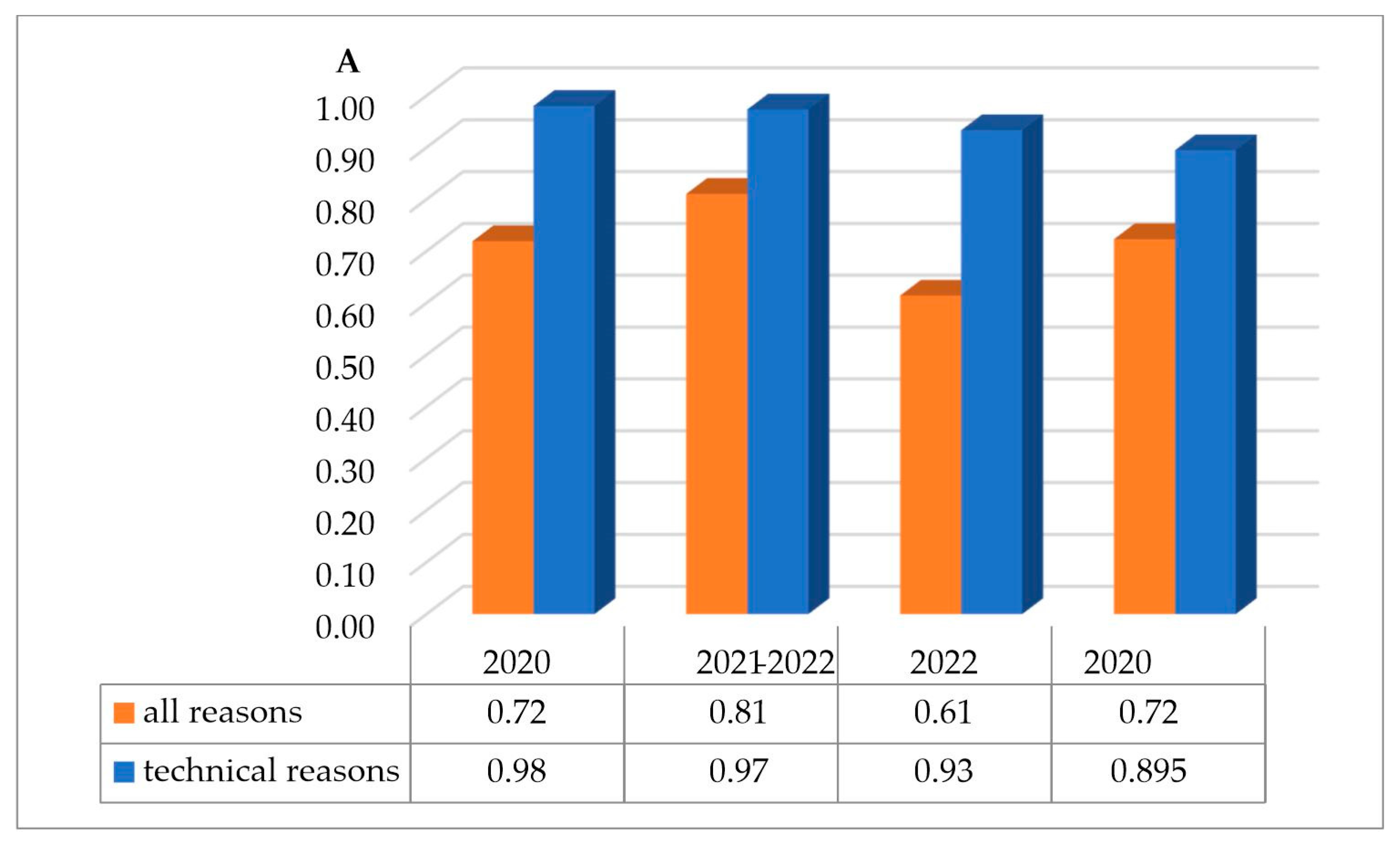1. Introduction
A level crossing is a junction where a railway line crosses a road at the same level [
1,
2], i.e., the railway line does not cross the road via an overpass or tunnel. Automatic level crossing devices (ALDs) are used to signal and protect road vehicles when a train is about to pass through the level crossing. They also provide information to the locomotive driver about the activated ALD, as well as to signal about a working ALD in the absence of a train in the area. Therefore, ALDs are a system for protecting railway crossings between stations and for providing information to the locomotive driver about safe crossings. They signal to road vehicles when a train is about to pass through the crossing: if the crossing device is in working order and there is no railway vehicle in the crossing notification zone, the signal indicates—with a white flashing light, and with a red flashing light—if there is a railway vehicle in this zone.
The safety of ALD operation is of the utmost importance, as safe passage through railway crossings must be ensured and accidents must not be allowed. In this paper, a statistical evaluation of data on the failures of ALDs is performed, and then reliability indicators are determined. The results obtained can be used in determining guidelines for the reconstruction and renovation of railway lines and signaling systems.
2. State of the Problem and Research Methodology
ALDs are a part of the inter-station devices of signaling systems. The “Signalling and Telecommunications” Departments (STDs) at the National Railway Infrastructure Company (NRIC) are responsible for the operation, repair and maintenance of signaling systems at Bulgarian Railways. The three units in Sofia, Plovdiv and Gorna Oryahovitsa are accountable for the activities in the respective areas. They collect data on failures of all devices of signaling system—their number and duration. The causes for the appearance are also indicated—as a result of technical or other reasons (assaults, theft, vandalism, incidents, activities of other organizations, natural disasters, etc.). Every year, NRIC issues an annual consolidated report of activity based on the collected data. The failures and their duration are systematized by device type:
indoor station devices—these are interlocking stations (ILSs), and the following types operate in Bulgarian railways: route-computer interlocking stations (RCISs), route-relay interlocking stations (RRISs), electromechanical interlocking stations (EMISs), relay systems for key dependences (RSKDs) and temporary traffic lights control panels [
3];
outdoor station devices (OSDs)—point machines, traffic lights, rail current circuits and axle counters (RCS_ACs);
inter-station devices (IsDs)–ALDs, relay semi-automatic interlocking (PAB type), automatic interlocking (AB type), automatic locomotive signaling and points on open road [
4];
telecommunications (TCs)—automatic telephone switches (ATC type) and external telecommunications lines (TCLs).
This research analyzes failures of automatic level crossing devices across the country over a three-year period (2020–2022) and compares them with failures of other equipment.
The study begins with a statistical evaluation of device failures using the information given in the annual consolidated reports of the activity. The following calculations are performed [
5]:
where
N—total number of types of devices monitored in the interval
Δt;
ri(Δt)—number of failures of a particular device type in the monitored interval Δt;
Δt = 365 × 24 = 8760 h (1 year) or Δt = 3 × 365 × 24 = 26,280 h (3 years).
where
ti(Δt)—duration of failures of a particular type of signaling devices in the monitored interval
Δt.
where
nf i—percentage ratio of failures of the
ith type of signaling devices.
where
tf i—percentage ratio of duration of failures of the
ith type of signaling devices.
Using these expressions, the share of failures and their duration for all device types can be calculated and compared. Furthermore, the devices with the highest number of failures and the longest duration can be identified.
The study continues with the determination of reliability indicators of the ALDs using the following equations [
6,
7,
8,
9]:
where
tALD (Δt) is the duration of failures of ALDs for the monitored period
Δt;
where
rALD(Δt) is the number of failures of ALDs for the period
Δt;
NALD = 524—number of ALDs in Bulgarian railways (it did not change during the three-year study period).
The following ratio can be assumed to represent the average number of failures per one ALD during the observed period:
It should be noted that the ALDs are recoverable objects, and MTBF is the basic parameter for fault tolerance. The coefficients and are complex indicators—they characterize both the failure-free operation and repairability of the devices and give a more accurate evaluation of their reliability.
3. Research Results
3.1. Statistical Evaluation of Failures and Their Duration
Information on ALD failures across the country during the monitored period (2020–2022) is systematized in
Table 1, with the number and duration of ALD failures due to various causes grouped separately [
10,
11]. Data are based on [
12] and are processed according to Equations (1) and (2).
Then the share of failures
nf and their duration
tf were calculated using Equations (3) and (4), not only for ALDs but also for all types of signaling devices. The correlation of failures on different equipment types are shown graphically in
Figure 1,
Figure 2,
Figure 3 and
Figure 4 (by year and for the three-year period, respectively). As can be seen, the percentages of failures and their duration for ALDs are some of the highest—about 20% for each period, reaching 25% for 2022. A higher percentage is only reached for failures of rail current circuits and axle counters.
In general, failures on external devices (inter-station IsDs and outdoor station OSDs) are higher than those on internal devices (interlocking stations ILSs and automatic telephone exchanges ATC type). They are under the influence of climatic conditions (temperature, rain, snow, etc.), and the risk of theft, vandalism and other encroachments is higher.
In particular, regarding ALDs, the risk of transport accidents is the greatest, e.g., breaking a barrier beam when a vehicle attempts to pass when prohibited due to an oncoming train. In such a case, the duration of the failures can hardly be predicted, as it is usually also related to a police investigation. That is why the values of failures for other reasons and their duration in
Table 1 are much higher compared to those for technical reasons. In addition, it is necessary to move the repair crew to the accident site, which also requires time. However, the duration of failures is relatively lower than that for track current circuits and axle counters, as no time is needed to accurately locate the fault. It is also valid for the external telecommunications lines—the percentage duration of failures in them is much greater than the percentage of failures.
3.2. Analysis of Reliability of ALDs
First, simple reliability indicators have been defined—the time for failure-free operation
τ(Δt) for different periods
Δt using Equation (5), the statistical assessment of the intensity of the failures flow
using Equation (6) and
MTBF using Equation (8). All indicators are calculated in two ways—considering all failures and their duration or only those due to technical reasons. The results obtained for the main simple indicator
MTBF are shown graphically in
Figure 5. It is obvious that the mean time between failures due to technical reasons significantly exceeds the indicator when all failures are considered. This once again confirms the conclusion that the downtime due to non-technical reasons can be difficult to determine.
Second, the coefficients of availability and unavailability have been determined using Equations (9) and (10) again in two ways. The results obtained for the availability coefficients in both ways (considering all failures and their duration or only those due to technical reasons) are shown graphically in
Figure 6. Again, it is obvious that the coefficients regarding technical failures significantly exceed the indicator when all failures are taken into account and are greater than 0.9. For 2020 and 2021 the coefficient is in the range 0.97–0.98, while for 2022 it is lower—0.933 (the number of failures in this year had increased, as well as their duration). For the three-year period it is close to 0.9, which is also a relatively high value.
This value was compared with the availability coefficients of the indoor devices, and the results are displayed graphically in
Figure 7. It can be seen that the indicator of some of interlocking stations is even lower than that of ALDs.
Similarly, indicators can be calculated when considering only failures due to other reasons (non-technical) and their duration. In this case, lower values of the availability coefficients will be obtained.
4. Discussion
An analysis can also be carried out by sections (lines and specific ALDs), calculating the availability coefficients in both ways. It can then be determined for which devices the availability coefficient calculated in relation to failures due to technical reasons is lower and measures can be taken to modernize or replace the ALD type [
10,
11,
13].
On the other hand, for devices with a lower availability coefficient calculated in relation to failures due to other reasons, it is necessary to consider a change in the infrastructure—construction of an overpass, tunnel, etc.
Thus, the results obtained can be used in determining guidelines for the reconstruction and renovation of signaling systems and railway lines, as well as in identifying conflict points where multi-level crossings should be implemented.
5. Conclusions
Automatic level crossing devices are the most critical facilities in railway infrastructure due to the intersection of the railway with the road and the danger of accidents due to the inattention of road vehicle drivers. ALDs must ensure safe passage, and their reliable and secure operation is of utmost importance.
This paper analyses failures of ALDs in the railway infrastructure in Bulgaria for the period 2020–2022 and determines reliability indicators.
It should be noted that performing only a statistical analysis is not enough; it is necessary to determine the reliability indicators and, above all, the availability coefficient.
Author Contributions
Conceptualization, E.D.; methodology, E.D.; software, V.D. and D.D.; validation, E.D., V.D. and D.D.; formal analysis, E.D. and V.D.; investigation, E.D. and V.D.; resources, E.D.; data curation, E.D. and V.D.; writing—original draft preparation, V.D.; writing—review and editing, V.D. and D.D.; supervision, E.D. and V.D.; project administration, E.D. and V.D.; funding acquisition, E.D. and V.D. All authors have read and agreed to the published version of the manuscript.
Funding
This research is part of the project KP-06-H57/12, granted by Bulgarian National Science Fund.
Institutional Review Board Statement
Not applicable.
Informed Consent Statement
Not applicable.
Data Availability Statement
No new data were created or analyzed in this study.
Conflicts of Interest
The authors declare no conflicts of interest.
Abbreviations
The following abbreviations are used in this manuscript:
| AB | Automatic interlocking |
| ALDs | Automatic level crossing devices |
| ATC | Automatic telephone exchanges |
| EMISs | Electromechanical Interlocking stations |
| IsDs | Inter-station devices |
| ILSs | Interlocking stations |
| OSDs | Outdoor station devices |
| PAB | Relay semi-automatic interlocking |
| RCISs | Route-Computer Interlocking stations |
| RCS_ACs | Rail current circuits and axle counters |
| RRISs | Route-Relay Interlocking stations |
| TCLs | External telecommunications lines |
| TCs | Telecommunications |
References
- Theeg, G.; Vlasenko, S. Railway Signalling and Interlocking, 3rd ed.; PMC Media House GmbH: Leverkusen, Germany, 2020. [Google Scholar]
- Pachl, J. Railway Signalling Principles; Technische Universität Braunschweig: Braunschweig, Germany, 2020. [Google Scholar]
- Nedelchev, N.N.; Hristov, H.A. Electrical Interlocking Devices; University of transport: Sofia, Bulgaria, 2008. [Google Scholar]
- Morgan, C.W. A System of Automatic Train Control; Creative Media Partners: London, UK, 2022. [Google Scholar]
- Huang, C.W.; El Hami, A.; Radi, B. Overview of Structural Reliability Analysis Methods—Part I: Local Reliability Methods; ISTE OpenScience, ISTE Ltd.: London, UK, 2016. [Google Scholar]
- Ross, S.M. Introduction to Probability Theory. In Introduction to Probability Models, 13th ed.; Elsevier Inc.: Amsterdam, The Netherlands, 2024. [Google Scholar]
- Bastidas-Arteaga, E.; Soubra, A.-H. Reliability Analysis Methods. In Stochastic Analysis and Invers Modelling; University of Nantes: Grenoble, France, 2014; pp. 53–77. ISBN 978-2-9542517-5-2. [Google Scholar]
- Terje, A. Introduction to reliability analysis. In Risk Analysis; John Wiley & Sons Ltd.: Hoboken, NJ, USA, 2015. [Google Scholar]
- Kumar, V.; Singh, L.; Tripathi, A.K. Reliability analysis of safety-critical and control systems: A state-of-the-art review. IET Softw. 2018, 12, 1–18. [Google Scholar] [CrossRef]
- Efanov, D.V.; Osadchy, G.V.; Khóroshev, V.V. New Stage in Safety Traffic Control Technologies Development: Digital Railroad Crossing. In Proceedings of the 2019 International Russian Automation Conference (RusAutoCon), Sochi, Russia, 8–14 September 2019; pp. 1–6. [Google Scholar] [CrossRef]
- Yun, J.; Tang, W. Automatic Threshold Adjustment for Predictive Level Crossing Sampling Data Converters. In Proceedings of the IEEE 67th International Midwest Symposium on Circuits and Systems (MWSCAS), Springfield, MA, USA, 11–14 August 2024; pp. 1033–1035. [Google Scholar] [CrossRef]
- Annual Consolidated Reports of Activity, NRIC, 2020, 2021, 2022. Available online: https://rail-infra.bg/bg/216 (accessed on 22 April 2025).
- Efanov, D.V.; Khóroshev, V.V.; Osadchy, G.V. Principles of Safety Signalling and Traffic Control Systems Synthesis on Railways. In Proceedings of the 2023 International Conference on Industrial Engineering, Applications and Manufacturing (ICIEAM), Sochi, Russia, 15–19 May 2023; pp. 634–638. [Google Scholar] [CrossRef]
| Disclaimer/Publisher’s Note: The statements, opinions and data contained in all publications are solely those of the individual author(s) and contributor(s) and not of MDPI and/or the editor(s). MDPI and/or the editor(s) disclaim responsibility for any injury to people or property resulting from any ideas, methods, instructions or products referred to in the content. |
© 2025 by the authors. Licensee MDPI, Basel, Switzerland. This article is an open access article distributed under the terms and conditions of the Creative Commons Attribution (CC BY) license (https://creativecommons.org/licenses/by/4.0/).














